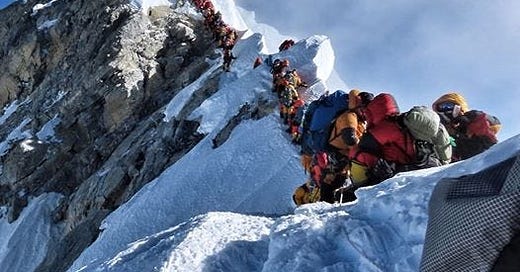Colin here. One of the most astounding feats of modern athleticism and mountaineering happened a few years ago, and it was somewhat lost in the madness that has been the 2020s. In 2019, a Nepalese former Gurkha and British Special Boat Service soldier climbed all 14 of the world’s 8,000-meter-high mountains in 189 days—a feat that has taken other climbers years to achieve. It is a record that will be incredibly hard to beat.
WITI Classifieds:
We are experimenting with running some weekly classifieds in WITI. If you’re interested in running an ad, you can purchase one through this form. If you buy this week, we’ll throw an extra week in for free on any ad. If you have any questions, don’t hesitate to drop a line.
Royal Braun connects cutting edge companies with key creative talent. Meet Royal Braun
Coaching for creative professionals who want deeper personal insight, a conviction in their work, and to make waves in the art world. Subscribe to Mission
Nudge, get customer insights with ease. Try Nudge
Despite his mountaineering prowess, Nirmal “Nims” Purja was propelled into wider culture when one of his photos (below) from the Hilary Step on Everest, showed a complete logjam of climbers, reinforcing the fears about congestion creating a death trap on the world’s highest mountain and forcing policy changes from Nepal.
His feat, dubbed Project Possible, included taking down some of the world’s most fearsome summits. These included more technical climbs than Everest itself, such as K2, where some of the most dangerous and technical climbing comes near the summit, in the death zone.
According to the Guardian:
Climbing all of the Himalayan giants has long been one of mountaineering’s most sought-after prizes, and was first achieved by Reinhold Messner in 1986, who was also was the first to climb all the 8,000ers without supplemental oxygen. In 2010, Edurne Pasaban became the first woman to complete all the 8,000ers.
Purja opted to use supplementary oxygen for his ascents, justifying his choice by the huge size of the challenge he had set himself.
Why is this interesting?
This challenge here is perhaps more than just shattering the speed record for a marathon (which is obviously an insane feat). There were a lot of moving pieces to this particular achievement.
First, having the endurance and ability to do technical climbs at high altitude, and turn around and do another one on short notice is astounding. High-altitude climbing like this takes a major toll on the respiratory system and musculature.
Second, for any of this to actually happen, the climate had to cooperate. Weather is often one of the mitigating factors of mountaineering, and if you don’t hit the window, the summit doesn’t happen.
Finally, you have the dangers of climbing itself. Bad things happen, often. Everest’s Khumbu Icefall was described to me by a mountaineering friend as an “ice cube tray held upside down.” There’s no knowing when it's going to unleash an avalanche or deadly shards of ice. Extrapolate this danger to thirteen other mountains over almost seven months, and you get a sense of what kind of chaos could ensue.
According to the BBC, in September 2019, "his challenge was held up while he waited for permission to climb the final mountain, Shishapangma, in the Tibetan autonomous region of China." That permission eventually came through after Nepal's government requested help from China. Mingma David Sherpa, who accompanied Purja on nine of the climbs, also became the youngest person to summit all 14 of these peaks.
When you double-click on his career, Nims Purja succeeded in one of the most difficult selection courses on the face of the earth: The British special operations selection. This is a gut check that highlights endurance, and a never quit attitude. Many people with similar credentials couldn’t pull off what he did. The intangibles, specifically bravery and fortitude, got him over the line. It is a record that is unlikely to be broken anytime soon. (CJN)
—
Thanks for reading,
Noah (NRB) & Colin (CJN)
—
Why is this interesting? is a daily email from Noah Brier & Colin Nagy (and friends!) about interesting things. If you’ve enjoyed this edition, please consider forwarding it to a friend. If you’re reading it for the first time, consider subscribing.





